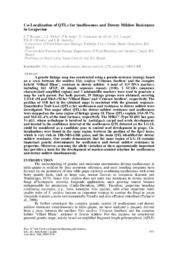Co-localization of QTLs for seedlessness and downy mildew resistance in grapevine.
Co-localization of QTLs for seedlessness and downy mildew resistance in grapevine.
Author(s): REVERS, L. F.; SILVA, D. C. da; LAMPE, V. S.; OLIVEIRA, P. R. D. de; GARRIDO, L. da R.; WELTER, L. J.; IRALA, P. B.
Summary: A genetic linkage map was constructed using a pseudo-testcross strategy based on a cross between the seedless Vitis vinifera ?Crimson Seedless? and the complex hybrid ?Villard Blanc?, resistant to downy mildew. A total of 315 DNA markers, including 262 AFLP, 48 simple sequence repeats (SSR), 2 SCARs (sequence characterized amplified region) and 3 minisatellite markers were used to generate a map for each parent. For both parents, 19 linkage groups were obtained, covering 1,111.0 cM and 926.0 cM for ?Villard Blanc? and ?Crimson Seedless?, respectively. The position of SSR loci in the obtained maps is consistent with the genomic sequence. Quantitative Trait Loci (QTLs) for seedlessness and resistance to downy mildew were investigated. Two major effect QTLs for downy mildew resistance and seedlessness were mapped on the same region of linkage group 18. These QTLs explain 25.0-55.7% and 54.0-62.,4% of the total variance, respectively. The MIKCC-Type MADS box gene VvAG3, whose orthologue is involved in Arabidopsis carpel and ovule development, and located in the confidence interval of the seedlessness QTL detected on the LG 18, could be considered as a candidate gene to control seed development in grape. Co-localizations were found in the same region, between the position of the Rpv3 locus, which is very rich in TIR-NBS-LRR genes, and the main QTL identified for downy mildew resistance. Our results demonstrate that the same region of LG 18 contains important genetic determinants for seedlessness and downy mildew resistance in grapevine. Moreover, assessing the allelic variation at these agronomically important loci provides a basis for the development of marker-assisted selection for seedlessness and downy mildew simultaneously.
Publication year: 2010
Types of publication: Abstract in annals or event proceedings
Unit: Embrapa Grape & Wine
Observation
Some of Embrapa's publications are published as ePub files. To read them, use or download one of the following free software options to your computer or mobile device. Android: Google Play Books; IOS: iBooks; Windows and Linux: Calibre.
Access other publications
Access the Agricultural Research Database (BDPA) to consult Embrapa's full library collection and records.
Visit Embrapa Bookstore to purchase books and other publications sold by Embrapa.

